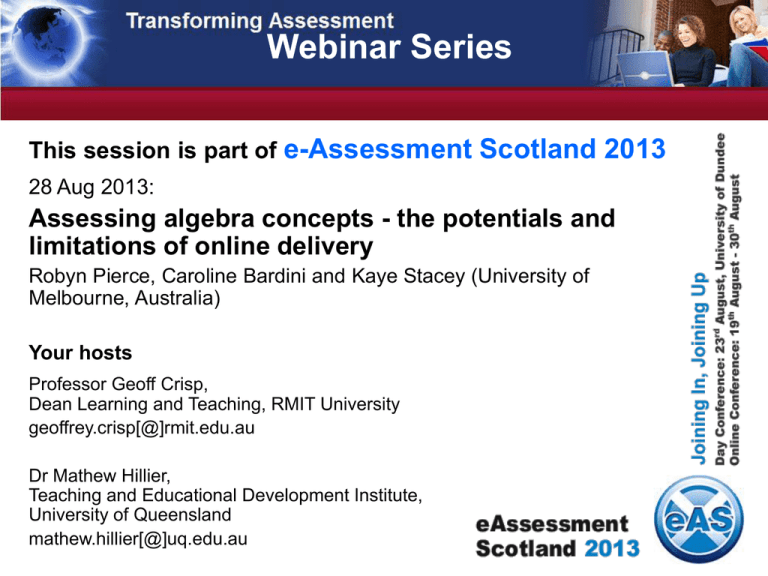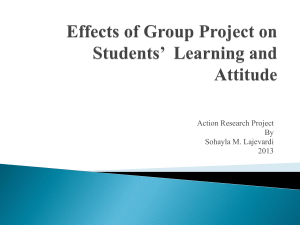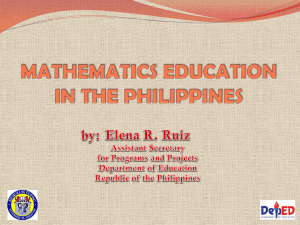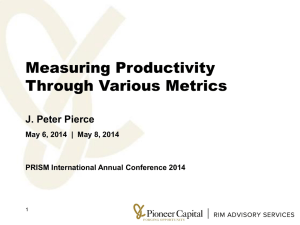eAS_28_aug_2013 - Transforming Assessment
advertisement

Webinar Series This session is part of e-Assessment Scotland 2013 28 Aug 2013: Assessing algebra concepts - the potentials and limitations of online delivery Robyn Pierce, Caroline Bardini and Kaye Stacey (University of Melbourne, Australia) Your hosts Professor Geoff Crisp, Dean Learning and Teaching, RMIT University geoffrey.crisp[@]rmit.edu.au Dr Mathew Hillier, Teaching and Educational Development Institute, University of Queensland mathew.hillier[@]uq.edu.au Assessing algebra concepts. The potentials and limitations of online delivery Robyn Pierce (Presenter) Caroline Bardini Kaye Stacey University of Melbourne Australia, Victoria, Melbourne Presentation authors Robyn Pierce Presenter Caroline Bardini Kaye Stacey Presentation Outline Pilot project funded by the Australian government’s Office of Learning and Teaching. • Preliminary online mathematics survey –issues of framing items for use online. • Preliminary findings about first year university students' understanding of functions • Examples of Specific Mathematical Assessments that Reveal Thinking (SMART tests) proposed to identify student thinking and provide feedback and advice to teaching staff. Project rationale Recent report from Australia’s Chief Scientist (Mathematics, Engineering & Science in the National Interest (Chubb et al, 2012)) The proportion of students at school studying mathematics and science is still declining, especially at the highest level, and in universities is virtually flat. Figure 1.4 Student participation in mathematics, 19952010 Project rationale • The need to increase the success rate in the mathematical sciences at first year and improve their sense of mastery and confidence to continue is vital. • “This is not about ‘dumbing down’. It is not in Australia’s interest to produce a raft of people with second rate skills and knowledge.” (Chubb et al, p20). • Previous research has shown that many people who are apparently ‘successful’ secondary school students harbour incorrect or incomplete conceptions of fundamental mathematical ideas. • Through extensive targeted practice in Year 12, students may ‘paper-over’ their fundamental difficulties and become adept at answering examination questions and so proceed to university without robust understanding. Project rationale • Strategies already developed to support students include Mathematics and Statistics Learning Centres where individual assistance is available to students, especially those in first year. • Diagnostic tests are not conducted at Melbourne because they are currently – too expensive – too time consuming – there is limited opportunity for remediation. Project rationale Assessment for Learning 10 Assessment for learning Diagnosing Interpreting & planning Teaching Diagnostic assessment Tutors Content and Curriculum Knowledge Tutor’s Mathematics Pedagogical Content Knowledge Expect university mathematics tutors have 11 strong CK but limited MPCK: Project details -Stage 1 Aim Develop a current evidence base for incorrect or incomplete fundamental algebraic conceptions prevalent amongst commencing first year undergraduate mathematics and statistics students. Project details – Stage 1 Evidence (i) data from all first year undergraduate mathematics and statistics students at the University of Melbourne via a brief survey and timed screening task through the university’s Learning Management System (ii) ‘think aloud’ interviews with volunteer students (iii) interviewing experienced teaching staff Project details -Stage 2 Make innovative use of technology to produce sample Specific Mathematical Assessments that Reveal Thinking (SMART tests) to add a different dimension to the assessment for learning that has been offered in the past to first year students. Project details -Stage 3 Produce online feedback, illustrating appropriate teaching strategies and examples for use with students who are identified as having specific misconceptions. Project details: focus Pilot project limited to algebra. Undergraduates’ misconceptions in two key areas of algebra to be identified: “variables, unknowns and parameters” and “functions and variation”. Resources will target the most common first year “hot spots”. Focus on functions • Verbalise: define or describe • Recognise functions in multiple representations: – Algebraic – Graphic – Numeric • Manipulate functions On-line quiz Maths quiz via LMS –Advantages • Platform widely used by uni teachers across faculties and subjects (repository of lecture notes, announcements –not exclusive to assessment) • Students are familiar with it (no extra burden on technology skills) • LMS provides direct link to students’ information (subject, etc.) • Variety of types of assessments (anonymous surveys, tests, etc – each with different features) • Export of students’ responses directly to Excel (however in a rather undigestible format…) Features of our quiz • One attempt only • Limited on time (35 minutes) – most questions to be answered «quickly» (encouraging students’ first ‘reactions’), no calculations should be needed • Track record on number of accesses (with or without attempts), date, time, duration of attempt (‘unaswered’ responses at the end of quiz by a student who spent 35min might indicate a lack of time rather than ‘I don’t know how to do it’) Disadvantages – item design Maths editor is limited e.g. no simultaneous equations. Need to use Word editor, print screen, crop, save as image and then « attach » (see next slide). Lengthy process! Maths editor limitations Disadvantages –item design Quite rudimentary tools. Less friendly environment for students and little flexibility in using multiple features at once (e.g. cannot have multiple choice for different subquestions – see next slide) Rudimentary look/tools Originally: (taken from SMART test) Multiple choice for each response Rudimentary look/tools On-line: (LMS) Pen-and-paper vs online Originally: We hoped to have multiple choices for each a,b,c,d (as in e.g. a menu). But limitations forced ‘blanks’. Pen-and-paper vs online Online: To avoid constructed response (i.e. type into blanks as in pen-and-paper), we chose multiple choice. But this forced to separate each sub-question Pen-and-paper vs online • What was one question in pen-and-paper has become 4! • Might discourage students as it adds length to the test • Burden on unnecessary reading (by repeating same stimulus 4 times) Disadvantages – item responses • Although exported to Excel, a couple of hours had to be spent on re-arranging data into a more readable format (yet still hard to interpret) • Maths editor not available for students’ responses. Various consequences: – On design of the item (e.g. Originally : “f(x) = x2-x+2. Find f(f(x))”. Online: multiple choice for the coefficient of x2 in f(f(x))). Relieve students from typing a complex expression and avoid typos. – On the format of the answers collected (see next slide) Disadvantages – format of answers Need to have a human to look at each answer to decide if right or wrong (e.g. assuming typos, accepting whole equation –and not only answer, accepting non expanded form, etc.) Looking back… Even with its limitations, good support for our purposes Results to date • Misconceptions reported in the literature are still prevalent Reading, classifying, key word search Percentage of students including this concept n=383 Rule Unique y-value Vertical line test Mapping One-to-one or many-to-one Graph At least one valid statement 51 19 4 4 5 6 60 Dichotomy – auto-marked Rule Percentage who responded correctly n=383 Quadratic function 89 Linear function – general form 85 Hybrid - continuous 6 Hybrid- not continuous 44 Rule in words 2 variables 50 Rule in words 3 variables 61 Diagnostic test results and feedback For automatically marked items: – Number correct – Items correct – incorrect • No diagnosis of misconceptions • Advice based on score would be vague • We can do better – but this requires a more sophisticated system • The LMS quiz provided a quick screening tool providing us with evidence of the ‘hot spots’ to target • Develop tests targeting prevalent, incomplete or incorrect conceptions and feedback for teachers and students. SMART tests: what are they? SMART tests: example SMART test: feedback for teachers SMART test: feedback for teachers Teaching suggestions References Project – to be done • Development and trialling of SMART tests targeting important ‘hotspots’ for starting University mathematics • still to be completed… Thank you Further questions? Robyn Pierce Caroline Bardini Kaye Stacey r.pierce@unimelb.edu.au c.bardini@unimelb.edu.au k.stacey@unimelb.edu.au Try yourself at http://www.smartvic.com








